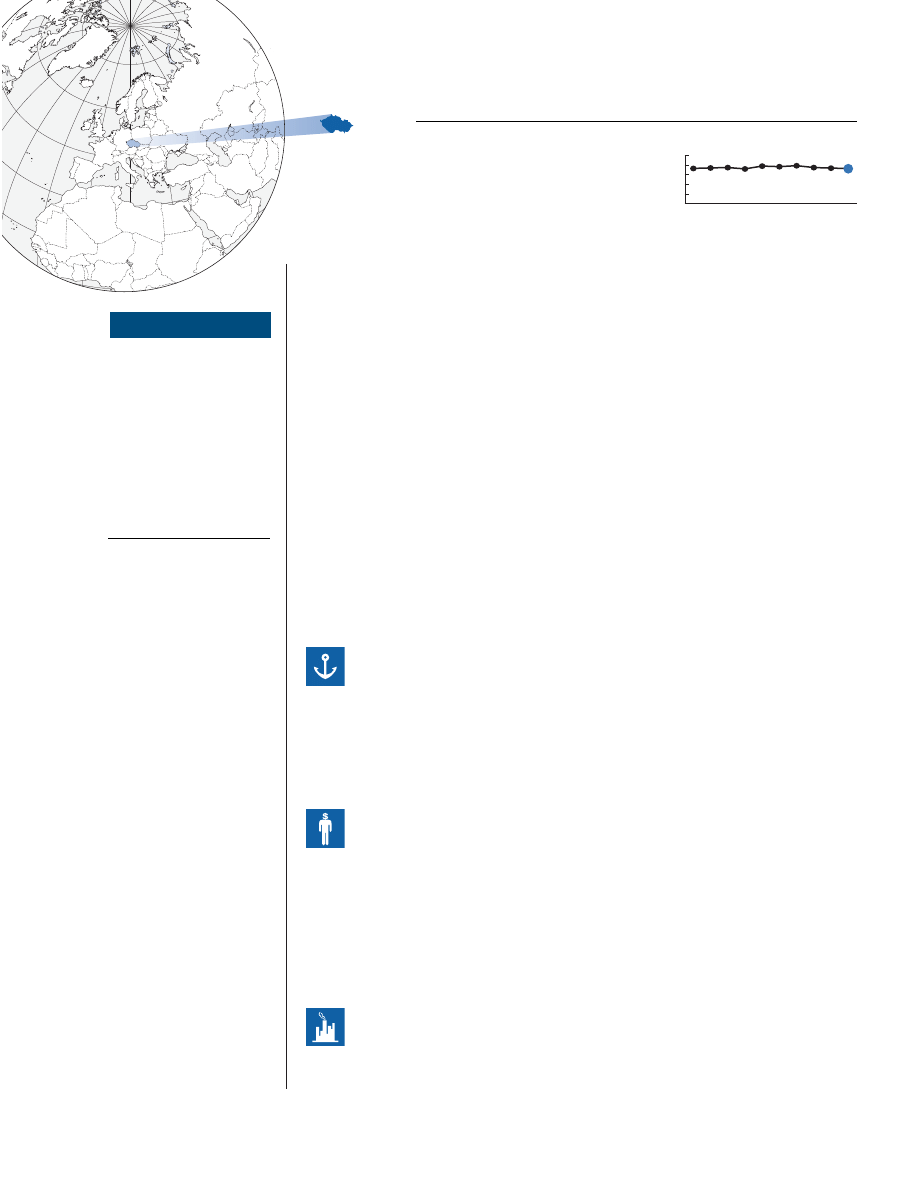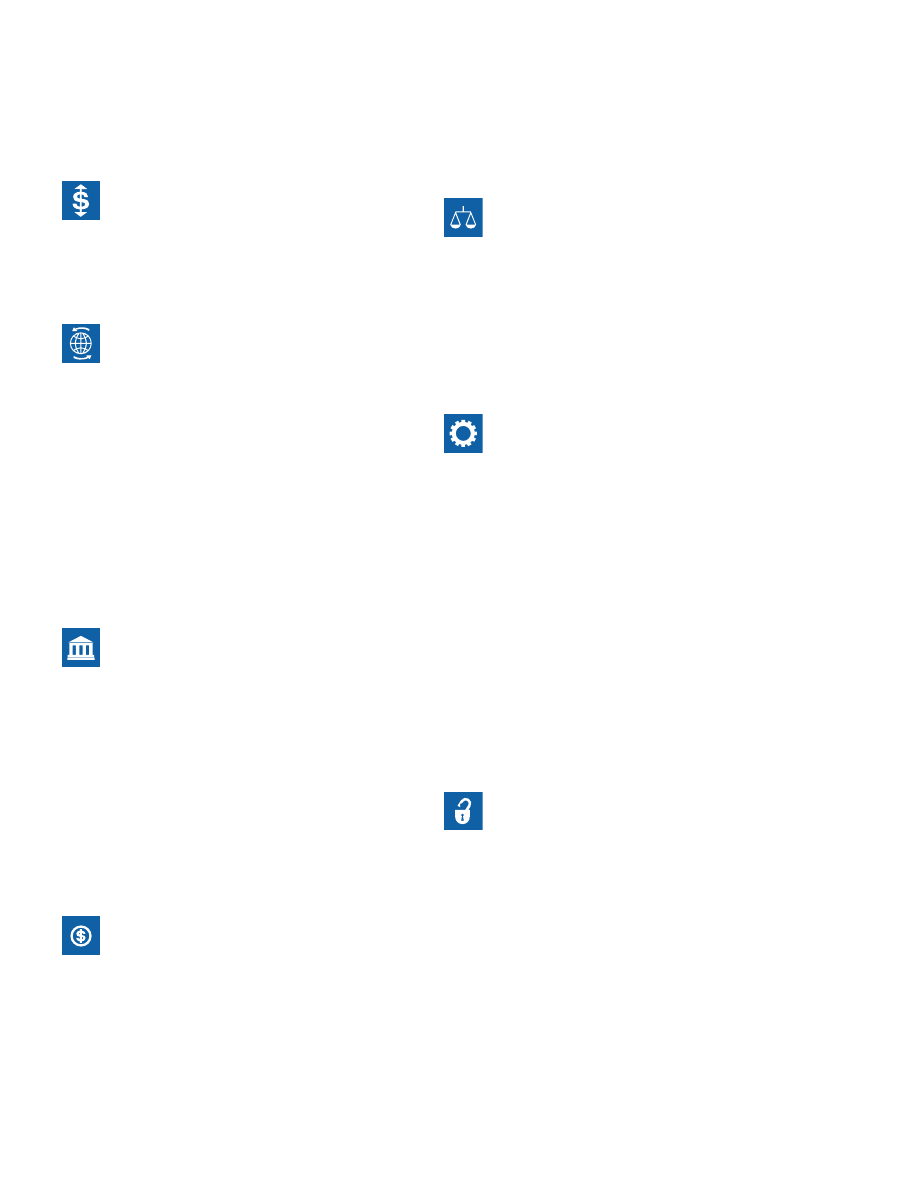
CZECH
REPUBLIC
R
U
S
S
I
A
FINLAND
AUSTRIA
ITALY
SPAIN
SWEDEN
NORWAY
GERMANY
FRANCE
PORTUGAL
HUNGARY
ROMANIA
BULGARIA
TURKEY
DENMARK
POLAND
BELARUS
UKRAINE
CZECH
SLOVAK
GREECE
CYPRUS
NETH.
BELGIUM
IRELAND
ALBANIA
MOLDOVA
LITHUANIA
LATVIA
ESTONIA
LUX.
BOSNIA
CROATIA
SLO.
SWITZERLAND
MACEDONIA
GREENLAND
ICELAND
C
I
ARMENIA
GEORGIA
SYRIA
IRA
U. K.
SERBIA
MONT.
Q U I C K S T U DY
T
he Czech Republic has one of Central Europe’s most developed and industrialized
economies. Exports to the European Union, especially Germany, and foreign investment
led economic growth in 2000–2002. The private sector accounts for nearly 80 percent of
GDP, but the government continues to retain ownership in many key industries. Challenges to
economic transformation include completing industrial restructuring, increasing transparency
in capital market transactions, covering the losses accumulated by formerly state-owned
banks, and reforming the health care and pension systems. In addition, the state-funded wel-
fare programs are excessively expensive and inefficient. A member of the NATO alliance since
1999, the Czech Republic has made a significant contribution to the war on terrorism by
deploying units with the International Security Assistance Force in Afghanistan. The Czech
Republic has finalized its accession to the EU in 2003 and will assume membership as early as
May 2004. The EU has contributed significant amounts of assistance to the Czech Republic,
preparing it for that accession. Weak minority governments since 1996 have led to the lack of
political consensus and decisive structural reform, but Prime Minister Vladimir Spidla, of the
center–left Czech Social Democratic Party, is committed to a stabilization strategy within a pol-
icy guided by EU standards that has hastened reforms in the administrative, regulatory, and
judicial systems. Former center–right Prime Minister Vaclav Klaus was elected President of the
Czech Republic by the Parliament on February 28, 2003, and will serve a five-year term. The
Czech Republic’s monetary policy score is 1 point better this year; however, its fiscal burden
of government score is 0.9 point worse, and its government intervention score is 0.5 point
worse. As a result, the Czech Republic’s overall score is 0.04 point worse this year.
TRADE POLICY
Score:
3–Stable
(moderate level of protectionism)
According to the World Bank, the Czech Republic’s weighted average tariff rate in 1999 (the
most recent year for which World Bank data are available) was 5.8 percent. The U.S.
Department of State reports that “technical barriers continue to hamper imports of certain
agricultural and food products…. A lack of consistency in the application of customs norms
can also act as a non-tariff barrier.”
FISCAL BURDEN OF GOVERNMENT
Score—Income Taxation: 3–Stable
(moderate tax rates)
Score—Corporate Taxation: 4–Stable
(high tax rates)
Score—Change in Government Expenditures: 4.5–Worse
(high increase)
Final Score:
3.9–Worse
(high cost of government)
The Czech Republic’s top income tax rate is 32 percent. The top corporate income tax rate is
31 percent. Government expenditures as a share of GDP increased 2.7 percentage points to
45.3 percent in 2002, compared to a decline of 4.3 percentage points in 2001. As a result, the
Czech Republic’s fiscal burden of government score is 0.9 point worse this year.
GOVERNMENT INTERVENTION IN THE ECONOMY
Score:
2.5–Worse
(moderate level)
The Economist Intelligence Unit reports that the government consumed 21.4 percent of GDP
in 2002, up from the 19.1 percent reported in the 2003 Index. As a result, the Czech Republic’s
SCORES
Trade Policy
3
Fiscal Burden
3.9
Government Intervention 2.5
Monetary Policy
1
Foreign Investment
2
Banking and Finance
1
Wages and Prices
2
Property Rights
2
Regulation
3
Informal Market
3.5
Population: 10,200,774
Total area: 78,866 sq. km
GDP: $58.1 billion
GDP growth rate: 2.0%
GDP per capita: $5,696
Major exports: machinery
and equipment, intermediate
manufactured goods, chemi-
cals, raw materials and fuels
Exports of goods and ser-
vices: $52.3 billion
Major export trading part-
ners: Germany 38.1%,
Slovakia 8.0%, Austria 5.8%,
Poland 5.2%, France 3.9%
Major imports: machinery
and transport equipment,
raw materials and fuels,
chemicals
Imports of goods and ser-
vices: $58.4 billion
Major import trading part-
ners: Germany 32.9%,
Slovakia 5.4%, Russia 5.5%,
Italy 5.3%
Foreign direct investment
(net): $8.1 billion
CZECH REPUBLIC
Rank: 32
Score: 2.39
Category: Mostly Free
2002 Data (in constant 1995 US dollars)
159
2.38 2.33 2.29 2.43 2.14 2.20 2.10 2.29 2.35
5
4
3
2
1
'04
'03
'02
'01
'00
'99
'98
'97
'96
'95
Present & Past Scores
2.39
(Best)
(Worst)

160
2004 Index of Economic Freedom
government intervention score is 0.5 point worse this year. In
2001, according to the International Monetary Fund, the
Czech Republic received 2.08 percent of its total revenues
from state-owned enterprises and government ownership of
property.
MONETARY POLICY
Score:
1–Better
(very low level of inflation)
Between 1993 and 2002, the Czech Republic’s weighted aver-
age annual rate of inflation was 2.81 percent, down from 4.56
percent between 1992 and 2001. As a result, the Czech
Republic’s monetary policy score is 1 point better this year.
CAPITAL FLOWS AND FOREIGN INVESTMENT
Score:
2–Stable
(low barriers)
The Czech Republic is open to foreign investment. Foreign
investors receive national treatment and may invest in near-
ly all sectors, with the exception of transport and industries
related to defense or national security. As of January 1, 2002,
non-Czech entities can acquire non-agricultural, non-forest
land. There are no restrictions on payments or proceeds
transactions or on current transfers, and both residents and
non-residents may hold foreign exchange accounts. Prior
authorization is required for issuance of debt securities and
money market securities. There are limits on open foreign
exchange positions. The U.S. Department of State reports that
a lack of transparency and a 10 percent preference for Czech
bidders impedes foreign tenders for government contracts.
BANKING AND FINANCE
Score:
1–Stable
(very low level of restrictions)
According to the U.S. Department of State, “The government
privatized the last state-owned bank in 2001 and…foreign-
controlled banks now manage 90% of total banking assets.”
Subject to approval by the central bank, a foreign bank may
establish a wholly owned bank, buy into an existing bank, or
open a branch. The Economist Intelligence Unit reports that,
as of March 2001, there were 63 banks, of which 26 were par-
tially or wholly foreign-owned. Czech banks are allowed to
sell securities and make some investments. The sector
remains burdened by a backlog of bankruptcy claims,
although reform of the bankruptcy code should help resolve
this situation.
WAGES AND PRICES
Score:
2–Stable
(low level of intervention)
The market sets most wages and prices. According to the
Economist Intelligence Unit, “The Price Law (Law 526/1990),
effective since January 1991, provides the government with
broad powers to regulate prices. In theory, the Ministry of
Finance can fix prices directly, set minimum or maximum
prices for any commercial transaction and establish periods
when prices may not change.… Despite its broad powers, the
government generally favours a laissez-faire pricing policy
on most products. Goods and services still subject to controls
include energy, some raw materials, domestic rents, and rail
and bus transport. Maximum prices also apply on mail and
telecommunications tariffs.” The government mandates a
minimum wage.
PROPERTY RIGHTS
Score:
2–Stable
(high level of protection)
Private property is well-protected. The Economist
Intelligence Unit reports that “contractual agreements are
generally secure in the Czech Republic.” According to the
U.S. Department of State, however, “Due to the newness and
inexperience of the Czech post-communist court system,
judicial decisions may vary from court to court. Commercial
disputes, particularly those related to bankruptcy proceed-
ings, can drag on for years.”
REGULATION
Score:
3–Stable
(moderate level)
Red tape and bureaucratic corruption are still a big problem.
According to the Financial Times, “Business leaders argue that
job creation would be easier if the government cut red tape
and corruption in the bureaucracy…. [F]oreign executives
say that the Czech Republic can still often be an opaque busi-
ness environment, particularly for smaller companies that
cannot take complaints to the prime minister.” The
Economist Intelligence Unit reports that “firms must meet
myriad local standards on health, hygiene, ventilation, and
utilities use, among others.” In addition, “to establish a com-
pany or change a registration, bundles of documents
stamped by notaries have to be submitted to a special judge
at a regional court.” This problem is further complicated by
the absence of office equipment, staff, and skills to handle the
workload. As a result, companies are almost forced to hire
lawyers and bribe officials to complete the process. Reform of
the civil service has been pushed back to 2005.
INFORMAL MARKET
Score:
3.5–Stable
(high level of activity)
Transparency International’s 2002 score for the Czech
Republic is 3.7. Therefore, the Czech Republic’s informal
market score is 3.5 this year.
Wyszukiwarka
Podobne podstrony:
Instrukcja IEF Algorytmy i struktury danych lab2
IEF Spain
IEF Unitedstates
IEF Poland
Instrukcja IEF Algorytmy i struktury danych lab1
Instrukcja IEF Algorytmy i struktury danych lab2
więcej podobnych podstron